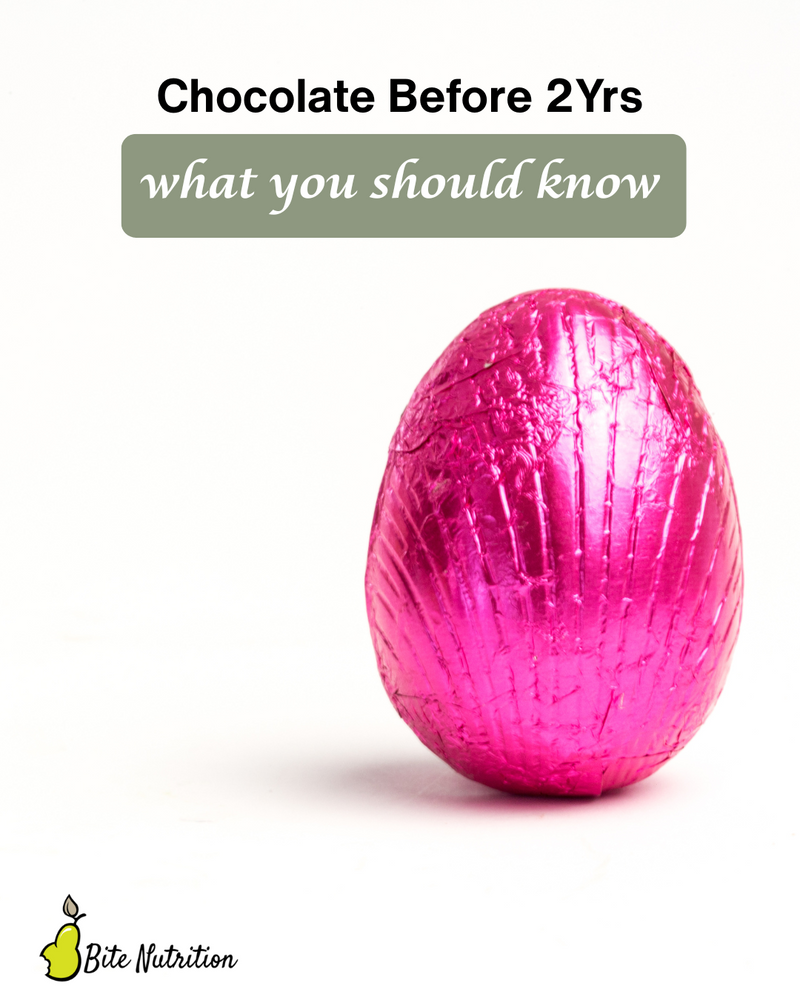Chocolate for Babies and Toddlers - What You Should Know

It is quite a common thing to say, "a little bit is not going to hurt!" (which doesn't always run true mind you). How much easier it would be, to make an informed decision, rather than speculating!
If you still think breast milk or formula still tastes good, you are not ready for the really sweet stuff.
So, what is the big deal about chocolate?
As a dietitian, I’m often asked when it’s appropriate to introduce treats, like chocolate, to young children. We feel like our kids are “missing out” and our desire for them to get into the good stuff is from a place of love. We forget that these early years are their true developmental year's, wiring their tastes, brains and bodies with the scaffolding of their long lives. We lose track of "just special occasions" and without knowing what chocolate really contains, we actually cannot make an informed decision.
Here’s why I recommend keeping chocolate off the menu until at least a child’s second birthday or longer if you can.
1. Excess Sugar and Early Taste Development
Chocolate, especially milk and white varieties, is high in added sugars. While the Australian Guidelines are not as explicit, according to the American Heart Association, children under 2 years of age should not consume any added sugars at all. This recommendation is based on compelling evidence that early exposure to added sugars can:
- Influence taste preferences, making children more likely to crave sweet foods later in life [1].
- Increase the risk of childhood obesity, which is associated with long-term health issues like type 2 diabetes and heart disease [2].
Most standard milk chocolate bars contain between 10 to 15 grams of sugar per 28-gram serving, well above the safe level for toddlers—who should ideally consume zero grams of added sugar per day.
2. Caffeine: An Overlooked Stimulant
Many people are surprised to learn that chocolate contains caffeine, a central nervous system stimulant that is not recommended for young children, especially infants and toddlers. Even small amounts can affect a young child’s developing neurological system, sleep patterns, and behavior.
To illustrate:
- 28 grams of dark chocolate contains about 12 milligrams of caffeine.
- 28 grams of milk chocolate contains around 6 milligrams.
The European Food Safety Authority (EFSA) recommends no more than 2.5 mg of caffeine per kilogram of body weight per day for children [3]. For a toddler weighing 10 kilograms, that’s just 25 mg per day—leaving little room for even small servings of chocolate when combined with other caffeine sources like tea or certain medications.
3. The Risk of Food Allergens
Chocolate products often contain milk, soy lecithin, and sometimes nuts, all of which are common allergens. Introducing these ingredients through candy—especially with multiple allergens at once—can complicate identifying and managing any allergic reactions. Health authorities now encourage early and deliberate introduction of common allergens, but in controlled, single-food formats, not as a side effect of a sugar-laden treat [4].
4. Nutrient Displacement and Gut Health
Young children have small stomachs and very specific nutrient needs. Every bite they take should ideally be packed with essential nutrients—iron, zinc, calcium, and healthy fats that support growth and brain development. Offering chocolate too early may displace more nutrient-rich options, such as fruits, vegetables, and whole grains.
Moreover, high sugar intake has been linked to changes in the gut microbiota composition in children, potentially impacting immune development and metabolic health [5].
What to Offer Instead
Babies and toddlers still think breast milk and formula tastes ok, so we know their tastes are very different to our adult tastes. Fruit offers a perfect level of sweetness while also offering other nutrition that is helpful for our child's development. For parents eager to introduce treats or celebrate special moments, consider naturally sweet and nutritious options:
- Mashed banana or soft baked apple slices with a sprinkle of cinnamon
- Yogurt blended with berries
- Homemade whole meal muffins sweetened with fruit purée
These options provide a more developmentally appropriate balance of flavors and nutrients without the unhelpful challenges of chocolate.
The Bottom Line
While a small taste of chocolate won’t necessarily cause harm, and especially if only on special occasions and you can keep track of these as being no more than a few times a year, the long-term implications of introducing sugary, caffeinated treats too early cannot be ignored. Waiting until after age two allows your child’s body, brain, and taste buds to develop in a healthier direction—setting them up for better choices later in life.
As a dietitian, my role is to support families with informed, evidence-based advice. And when it comes to chocolate for babies and toddlers, the message is clear: it’s worth the wait.
References
- Vos MB, Kaar JL, Welsh JA, et al. Added sugars and cardiovascular disease risk in children. Circulation. 2017;135(19):e1017–e1034. https://doi.org/10.1161/CIR.0000000000000439
- Birch LL, Fisher JO. Development of eating behaviors among children and adolescents. Pediatrics. 1998;101(3 Pt 2):539-549.
- EFSA Panel on Dietetic Products, Nutrition and Allergies (NDA). https://www.efsa.europa.eu/en/topics/topic/caffeine#faq. EFSA Journal. 2015;13(5):4102. https://doi.org/10.2903/j.efsa.2015.4102
- Greer FR, Sicherer SH, Burks AW. Effects of early nutritional interventions on the development of atopic disease in infants and children. Pediatrics. 2008;121(1):183-191.
- Miko A, Senn KA, Schrenzel J, et al. Sugar and the human gut microbiome: a review of evidence. Nutrition Reviews. 2023;81(1):1–13. https://doi.org/10.1093/nutrit/nuac059

